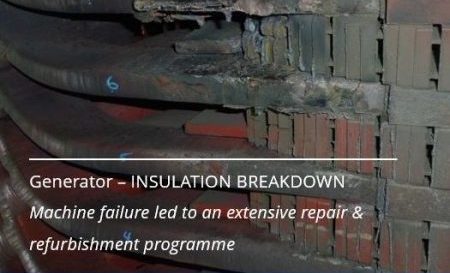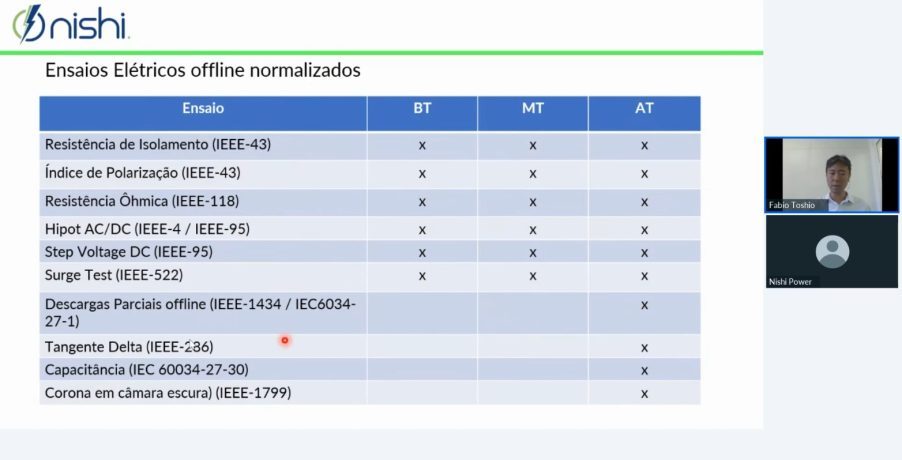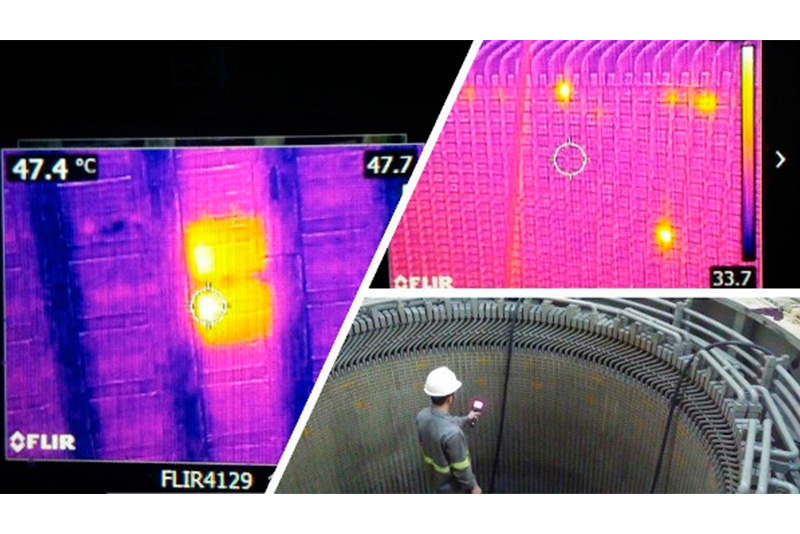Hydro-Generators
NISHI acts in the maintenance, manufacturing of components and specialized consulting for the evaluation of the insulating system of electrical machines. It has a multidisciplinary technical staff to evaluate the equipment and plan programmed and corrective interventions. It is specialized in the maintenance of hydroelectric generators of all sizes and power, consolidating its expertise in the manufacture of medium and high voltage bars and coils.
Electrical failure is the main risk associated with hydroelectric generators. Insulation failure, electrical faults and abnormal operating conditions can result in significant damage to the stator, core and rotor windings.
Hydrogenerators are also subject to mechanical failures, such as bearing damage, lack of lubrication and low efficiency in the cooling system, cracking of the stator structure, and rotor pole deformation.
Electrical and mechanical failures can cause serious damage to the generator and result in cascading effects, such as lubrication oil fires and electrical system instability, which can affect other generators.
Operation and maintenance according to the manufacturers’ instructions prevent losses, but further recommendations based on the following factors should be observed:
- Visual inspections;
- Operational history;
- Machine availability
- Electrical test results
- Condition monitoring results
- Failure history;
- Equipment alerts;
- Maintenance history;
- Previous disassembly report;
- Exposure to severe or abnormal operating conditions;
The most common failure modes in AC generators are related to the stator, core, and rotor.
STATOR
Stator winding failures occur when the insulating wall or inter-spiral insulation fails and allows a short circuit to occur.
Thermal deterioration failures occur when the generator is operated at temperatures above the thermal rating of the stator winding insulation. Problems in the insulation cause delamination of the mica tape layers of the insulation. There will be friction between the loose conductors that damage the insulation, resulting in electrical short circuits. Delamination of the mica tape layers also creates gaps in the insulation, where partial discharge activity can occur, and eventually erode a cavity in the insulation causing an electrical short circuit.
Causes of thermal deterioration include:
- Generator overload;
- Poor design or manufacturing;
- Poor thermal exchange caused by high ambient temperatures, blocked air filters, clogged heat exchanger tubes, and blockage of generator cooling passages and vents;
- Overexcited and underexcited operation of the generator continuously;
- Negative sequence currents caused by phase imbalance of the stator currents;
- High harmonics in the electrical system contributing to increased heating in the stator and core.
- Partial Discharge
The activity of partial discharges in the insulation tends to contribute to the evolution of voids present in the insulation. Over time, they can create enough stress to weaken the winding until a possible short circuit occurs
- Corona
The corona effect is a type of partial discharge that occurs at the stator endwinding, slot exit, and especially between phase coils.
- Duty Cycle
The load cycle causes insulation failure as a result of the difference in thermal expansion between the stator copper conductor and the insulating wall. The copper expands faster than the insulating wall and will result in an axial shear stress between the insulation of the insulating wall and the copper conductor. With repetitive load cycles, the copper will eventually separate from the grounding wall insulation. The gap created will allow partial discharge to occur. The gap also allows the copper conductors in the bar to loosen and vibrate, leading to insulation damage.
- Loose stator bars
Loose stator bars will vibrate radially in the groove. This causes the insulation to be worn away from the surface of the groove. The movement of the stator bar in the slot also generates discharge in the slot which, over time, becomes partial discharge as the semiconductor layer on the stator bar is worn away. The partial discharge will accelerate the deterioration of the insulation.
- Defective semiconductor coating
Stator bars in machines rated 6 kV and above are usually coated with paint or tape that use carbon raw material to give the coating a semiconductor property. However, oxidation of the carbon raw material can occur due to partial discharge activity or localized areas of high resistance in the coating. This will reduce the effectiveness of the semiconductor coating and allow more partial discharge activity to occur, eventually leading to insulation failure.
- Overvoltages
Overvoltages due to lightning, electrical faults, and switching will cause the insulation to fail if it is stressed beyond its ability to withstand.
- Contamination
Open air-cooled AC generators usually operate in environments where they are exposed to contaminants such as dust, salt spray, moisture, and chemicals. These open generators are susceptible to arcing, erosion, and chemical attack as a result of these contaminants.
- Core
The stator core is made of steel laminations. These laminations are insulated from each other to reduce the amount of eddy currents that are induced in the core. Eddy currents generate heat and losses in the generator. Deterioration of the interlaminar insulation will result in overheating and damage to the core. The damage can be severe and can result in damage to the windings.
ROTOR
Rotor insulation consists of two components: (1) insulation between the pole winding and the pole body, and (2) inter-wire insulation, which provides individual insulation between the windings of the rotor winding for each pole.
Pole insulation for small and large generators is generally the same. In modern machines, this consists of insulating glass laminate between the winding and the pole shoe that ensures the necessary dielectric and mechanical strength.
Insulation of the winding in smaller generators consists of enamel and fiberglass insulation of the conductor. In larger generators, spiral insulation consists of a separator of insulating material placed between each flat copper strip or tape of insulating material wrapped around the copper strips.
- Faulty connections between poles
Each pole in a salient pole rotor is connected in series by screwed or abraded interpolar connections. During operation, the rotor poles will move relative to each other, causing the interpolar connections to rub together. Over time mechanical fatigue can cause the interpolar connections to break, resulting in an open-field winding. It can occur even with flexible laminated interpolar connections.
- Rotor insulation failure
Rotor winding failures can also occur when the pole or spiral insulation fails and allows a short circuit to occur. It is possible for the generator to continue operating with shorted rotor windings. Shorted turns also result in increased vibration due to the asymmetric magnetic field.
Hydrogenerators cases
FREE WEBINAR: Generator failure – Root Cause Analysis (RCA) of 2 generators with insulation breakdown
Nishi and Quartzelec would like to invite you to attend the on-line meeting where we will be discussing: Generator failure - Root Cause Analysis (RCA) of 2 generators with insulation breakdown. We will be discussing
Electrical Tests: Low Voltage Winding x Medium High Voltage
Nishi-san's tips on medium and high voltage motor and generator maintenance are back, now with live broadcasts and open participant Q&A. Watch and participate in this online event with lots of technical content and the
Magnetic core – How to assess its quality and integrity?
In most rotors and stators, the core is formed by "stacking" steel plates (siliceous or not), insulated from each other and pressed uniformly, forming a solid whole. In machines that work at high temperatures (close
Would you like to receive exclusive content about electrical machines?
Nishi has specialized in repairing and maintaining your equipment for over 70 years.
Register your e-mail and receive all the news in the sector.








